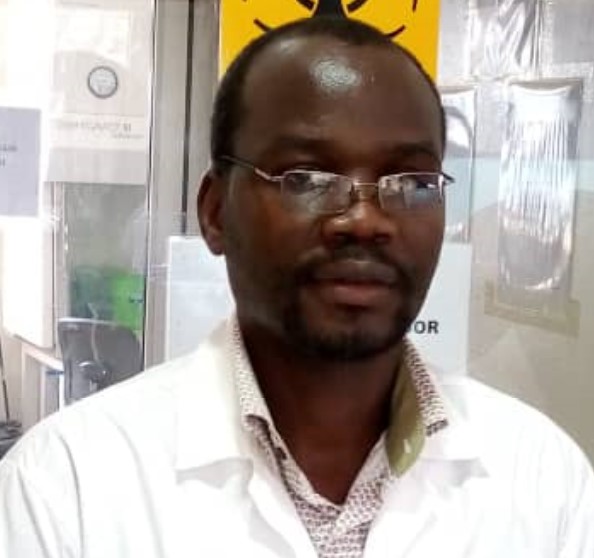

Dr
Oghenebrume Wariri
Current Organisation
MRC Unit The Gambia at London School of Hygiene and Tropical Medicine
Current Job Title
Clinical Research fellow
Biography
Publications
Using a mixed-methodology approach, we explored the experiences of caregivers in disclosing HIV status to children living with HIV in Nigeria
Background While vaccination plays a critical role in the global response to the COVID-19 pandemic, vaccine rollout remains suboptimal in Nigeria and other Low- and Middle-income countries (LMICs). This study documents the level of hesitancy among health workers (HWs) during the initial COVID-19 vaccine deployment phase in Nigeria and assesses the magnitude and determinants of hesitancy across Nigeria.
Methods A cross sectional study across all States in Nigeria was conducted with over 10,000 HWs interviewed between March and April 2021. Data were cleaned and analyzed with proportions and confidence intervals of hesitancy documented and stratification by HW category. We compared the level of confidence/acceptance to be vaccinated across Nigeria and documented the sources of negative information amongst HWs who refused the vaccine.
Findings Among the 10 184 HWs interviewed, 9 369 [92% (95% CI= 91, 92)] were confident of the COVID-19 vaccines and were already vaccinated at the time of this survey. Compared to HWs who were less than 20 years old, those aged 50 – 59 years were significantly more confident of the COVID-19 vaccines and had been vaccinated (OR=3.8, 95% CI=2.3 – 6.4, p<0.001). Only 858 (8%) of the HWs interviewed reported being hesitant with 57% (479/858) having received negative information, with the commonest source of information from social media (43.4%.)
Interpretation A vast majority of HWs who were offered COVID-19 vaccines as part of the first phase of national vaccine roll out were vaccinated and reported being confident of the COVID-19 vaccines. The reported hesitancy was due mainly to safety issues, and negative information about vaccines from social media. The issues identified remain a significant risk to the success of subsequent phases of the vaccine rollout in Nigeria.
Empiric studies exploring the timeliness of routine vaccination in low-and middle-income countries (LMICs) have gained momentum in the last decade. Nevertheless, there is emerging evidence suggesting that these studies have key measurement and methodological gaps that limit their comparability and utility. Hence, there is a need to identify, and document these gaps which could inform the design, conduct, and reporting of future research on the timeliness of vaccination. We synthesised the literature to determine the methodological and measurement gaps in the assessment of vaccination timeliness in LMICs. We searched five electronic databases for peer-reviewed articles in English and French that evaluated vaccination timeliness in LMICs, and were published between 01 January 1978, and 01 July 2021. Two reviewers independently screened titles and abstracts and reviewed full texts of relevant articles, following the guidance framework for scoping reviews by the Joanna Briggs Institute. From the 4263 titles identified, we included 224 articles from 103 countries. China (40), India (27), and Kenya (23) had the highest number of publications respectively. Of the three domains of timeliness, the most studied domain was ‘delayed vaccination’ [99.5% (223/224)], followed by ‘early vaccination’ [21.9% (49/224)], and ‘untimely interval vaccination’ [9% (20/224)]. Definitions for early (seven different definitions), untimely interval (four different definitions), and delayed vaccination (19 different definitions) varied across the studies. Most studies [72.3% (166/224)] operationalised vaccination timeliness as a categorical variable, compared to only 9.8% (22/224) of studies that operationalised timeliness as continuous variables. A large proportion of studies [47.8% (107/224)] excluded the data of children with no written vaccination records irrespective of caregivers’ recall of their vaccination status. Our findings show that studies on vaccination timeliness in LMICs has measurement and methodological gaps. We recommend the development and implement of guidelines for measuring and reporting vaccination timeliness to bridge these gaps
Background Limited understanding exists about the interactions between malaria and soil-transmitted helminths (STH), their potential geographical overlap and the factors driving it. This study characterised the geographical and co-clustered distribution patterns of malaria and STH infections among vulnerable populations in sub-Saharan Africa (SSA).
Methodology/Principal findings We obtained continuous estimates of malaria prevalence from the Malaria Atlas Project (MAP) and STH prevalence surveys from the WHO-driven Expanded Special Project for the Elimination of NTDs (ESPEN) from Jan 1, 2000, to Dec 31, 2018. Although, MAP provides datasets on the estimated prevalence of Plasmodium falciparum at 5km x 5km fine-scale resolution, we calculated the population-weighted prevalence of malaria for each implementation unit to ensure that both malaria and STH datasets were on the same spatial resolution. We incorporated survey data from 5,935 implementation units for STH prevalence and conducted the prevalence point estimates before and after 2003. We used the bivariate local indicator of spatial association (LISA analysis) to explore potential co-clustering of both diseases at the implementation unit levels among children aged 2–10 years for P. falciparum and 5–14 years for STH, living in SSA.
Our analysis shows that prior to 2003, a greater number of SSA countries had a high prevalence of co-endemicity with P.falciparium and any STH species than during the period from 2003–2018. Similar prevalence and distribution patterns were observed for the co-endemicity involving P.falciparum-hookworm, P.falciparum-Ascaris lumbricoides and P.falciparum-Trichuris trichiura, before and after 2003.
We also observed spatial variations in the estimates of the prevalence of P. falciparum-STH co-endemicity and identified hotspots across many countries in SSA with inter-and intra-country variations. High P. falciparum and high hookworm co-endemicity was more prevalent in West and Central Africa, whereas high P. falciparum with high A. lumbricoides and high P. falciparum with high T. trichiura co-endemicity were more predominant in Central Africa, compared to other sub-regions in SSA.
Conclusions/Significance Wide spatial heterogeneity exists in the prevalence of malaria and STH co-endemicity within the regions and within countries in SSA. The geographical overlap and spatial co-existence of malaria and STH could be exploited to achieve effective control and elimination agendas through the integration of the vertical control programmes designed for malaria and STH into a more comprehensive and sustainable community-based paradigm.
Background
The WHO Regional Office for the Africa Regional Immunization Technical Advisory Group, in 2011, adopted the measles control and elimination goals for all countries of the African region to achieve in 2015 and 2020 respectively. Our aim was to track the current status of progress towards measles control and elimination milestones across 15 west African countries between 2001 and 2019.
Methods
We did a retrospective multicountry series analysis of national immunisation coverage and case surveillance data from Jan 1, 2001, to Dec 31, 2019. Our analysis focused on the 15 west African countries that constitute the Economic Community of West African States. We tracked progress in the coverage of measles-containing vaccines (MCVs), measles supplementary immunisation activities, and measles incidence rates. We developed a country-level measles summary scorecard using eight indicators to track progress towards measles elimination as of the end of 2019. The summary indicators were tracked against measles control and elimination milestones.
Findings
The weighted average regional first-dose MCV coverage in 2019 was 66% compared with 45% in 2001. 73% (11 of 15) of the west African countries had introduced second-dose MCV as of December, 2019. An estimated 4 588 040 children (aged 12-23 months) did not receive first-dose MCV in 2019, the majority (71%) of whom lived in Nigeria. Based on the scorecard, 12 (80%) countries are off-track to achieving measles elimination milestones; however, Cape Verde, The Gambia, and Ghana have made substantial progress.
Interpretation
Measles will continue to be endemic in west Africa after 2020. The regional measles incidence rate in 2019 was 33 times the 2020 elimination target of less than 1 case per million population. However, some hope exists as countries can look at the efforts made by Cape Verde, The Gambia, and Ghana and learn from them.
Funding
None.
Project Title
Evaluating the impact of sociodemographic and geographic access to immunization service points on TIMEliness and deLaYs of infant vaccinations in The Gambia (TIMELY)
EDCTP Project
TMA2019CDF-2734
EDCTP Program
EDCTP2
EDCTP Project Call
Career Development Fellowship (CDF)
Host Organisation
| Department | Institution | Country |
|---|---|---|
| Medical Research Council (MRC) Unit - The Gambia | GM |
Project Objectives
1. To determine the proportion of Gambian infants (one year and below) at baseline (2019) who experienced a delay in the receipt of any of the vaccines given during the first year of life. 2. To monitor variations in routine vaccination timeliness and delays due to the COVID-19 pandemic. 3. To map ‘hotspots’ or cluster subpopulations with delayed vaccinations across the Gambia. 4. To determine sociodemographic and economic factors that contribute to the timeliness of vaccination among infants in the Gambia. 5. To determine the contribution of travel distance to the nearest immunization service point/ outreach post on the timeliness of receiving vaccination among infants in the Gambia. 6. To determine the contribution of the schedules of immunization service points (days/time of conducting immunization activities) on the timeliness of infant vaccination in The Gambia
Study Design
NA
Project Summary
The traditional metric used to evaluate the success of immunization programs is vaccine-specific crude vaccination coverage rates. However, this metric does not take into account whether vaccines were received on time as prescribed by the immunization schedule. As a result, it can mask substantial gaps related to untimely vaccinations. Untimely vaccination may haveimplications for disease outbreaks because it creates herd immunity gaps and windows of vulnerability, even in the presence of high crude vaccination coverage. The Gambia has consistently maintained high vaccination coverage rates above 90% for most vaccines in the last two decades, but emerging evidence suggests that there are also significant delays in vaccinating children. The overall aim of this study was to determine the contribution of sociodemographic characteristics and geographic access to the nearest immunization service points on timeliness and clustering of delays in receiving routine vaccinations administered during the infancy period in the Gambia The main data sources for the study include: Nationally representative data from the 2019/2020 The Gambia Demographic Health Survey Prospectively collected cohort data on routine childhood vaccination from the Basse and Farafenni Health Demographic and Health Surveillance system in The Gambia (2015 – 2021) Primary geospatial mapping data of all public immunization clinics in The Gambia, to be collected by the Fellow to aid the geospatial modelling of geographic accessibility to immunization clinics Progress to date All five objectives of the study have been completed as scheduled. The Fellow attended several training sessions needed to perform the analysis and also registered for a PhD as part of the EDCTP CDF, which they plan to complete in January 2024. Four academic papers have been published in peer-reviewed open access journals, based on direct outputs from the study. The Fellow has also disseminated the outcomes as oral presentations to varied audiences, including academic audiences in The Gambia and the UK, and immunization program managers in The Gambia. The Fellow also engaged lay audiences and the general public through Twitter, by publishing lay summaries on the institutional website, and through radio, local print media, and television. The findings from this Career Development Fellowship have provided key recommendations that could inform the design of future empiric research on the timeliness of routine childhood vaccination in LMICs. More importantly, the findings will likely inform programmatic recommendations that will help The Gambia's Expanded Programme on Immunization (EPI) program to design interventions to reach cluster sub-populations with untimely vaccination.


